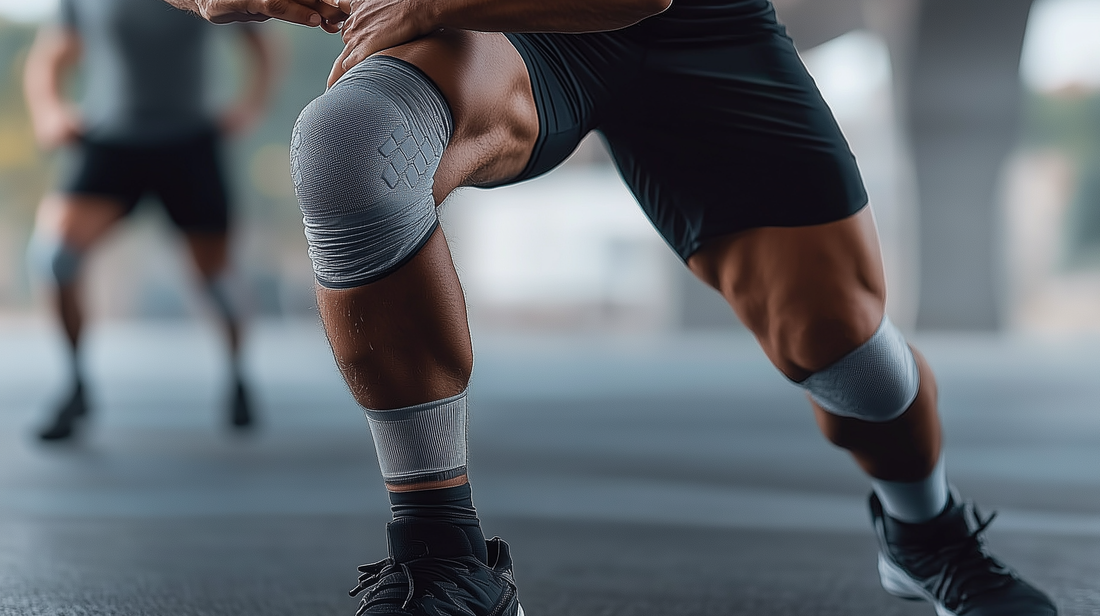
Can Knee Braces Prevent Injury While Running? Here’s What You Need to Know
Share
Running is one of the most popular forms of exercise worldwide, offering a wide range of health benefits, including improved cardiovascular fitness, enhanced muscle tone, and increased mental well-being. However, while running may feel natural and invigorating, it can also place significant strain on the body, particularly the knees. Knee injuries, ranging from minor discomfort to more severe issues, are common among runners. In fact, studies have shown that up to 50% of runners will experience a knee injury during their running lifetime (Jørgensen et al., 2013). As a result, many runners turn to knee braces as a potential solution to prevent injury and provide support during their training.
But do knee braces really prevent injury while running? This article explores the benefits, limitations, and when knee braces may be a helpful tool for runners.
Understanding Knee Injuries in Runners
Before diving into the role of knee braces, it's essential to understand the types of knee injuries runners commonly experience. Knee injuries can be categorized into overuse injuries, biomechanical issues, and trauma.
Runner's Knee (Patellofemoral Pain Syndrome): This is one of the most prevalent knee conditions for runners. It occurs when the cartilage under the kneecap is irritated, leading to pain in the front of the knee, especially during activities like running, squatting, or climbing stairs. Causes include muscle imbalances, poor alignment of the kneecap, and overuse.
Patellar Tendinitis: Also known as jumper’s knee, this condition involves inflammation of the tendon connecting the kneecap to the shinbone. It is common in athletes who perform high-impact activities, including running, especially if done in excess.
Iliotibial Band Syndrome (ITBS): The IT band runs along the outside of the thigh and can cause knee pain when it becomes tight and irritated, often due to repetitive running motions. ITBS can lead to inflammation on the outer part of the knee.
Knee injuries in runners typically stem from repetitive motion, improper running technique, muscle imbalances, or insufficient rest. If left untreated, these injuries can lead to long-term damage and hinder athletic performance.
What Are Knee Braces and How Do They Work?
Knee braces are devices designed to provide additional support to the knee joint. They come in various types, each designed for specific needs:
· Knee Sleeves: These are soft, elastic sleeves that provide compression and mild support, often used by runners for general knee discomfort.
· Stabilizing Braces: These offer more structured support, featuring straps or hinges that restrict knee movement to prevent injury.
· Hinged Braces: These are often used after knee surgery or for runners recovering from a more serious injury, offering significant support and stability.
Knee braces work by stabilizing the knee joint and surrounding muscles, reducing excessive movement that could lead to strain or injury. For runners, they can help alleviate pressure on ligaments, tendons, and cartilage, especially when running on hard surfaces or during long runs.

Do Knee Braces Actually Prevent Injury?
The effectiveness of knee braces in preventing injury has been debated, and research has provided mixed results. Some studies suggest that knee braces can reduce the risk of injury, while others indicate their effectiveness is limited without other complementary interventions, such as strength training and proper technique.
Research Findings: Studies on knee braces have indicated that they may reduce knee pain and improve function in people with certain knee conditions like runner’s knee and patellar tendinitis. A review published in Sports Medicine found that knee braces can reduce pain and improve knee function during activities (Van der Windt et al., 2005). However, the effectiveness of knee braces in preventing injury in healthy individuals is still under scrutiny.
Expert Opinions: Physical therapists and orthopedic experts agree that knee braces can be beneficial for runners with pre-existing knee issues or those recovering from an injury. They offer protection against further strain and promote healing. However, for those without any knee problems, knee braces are often unnecessary unless there is a specific concern, such as a history of knee injuries.
Benefits of Knee Braces: Knee braces are most helpful when used to provide additional support for a weakened or previously injured knee. They are also useful when a runner is returning from an injury and needs extra protection during rehabilitation. For runners with a history of knee injuries, wearing a knee brace may help reduce discomfort during exercise and allow them to continue running safely.
When Should You Use a Knee Brace While Running?
Knee braces may not be essential for every runner, but there are certain situations in which they can be particularly helpful:
After an Injury: Knee braces are commonly used after knee injuries such as ligament strains, fractures, or surgeries. They provide support while the knee heals and reduce the risk of re-injury during recovery.
During Rehabilitation: For runners recovering from knee injuries like patellar tendinitis or IT band syndrome, knee braces can provide temporary relief and support during physical therapy exercises or light running sessions.
As a Preventive Measure: If you have experienced frequent knee pain or strain, wearing a knee brace while running may help prevent further damage. In this case, the brace can provide extra stability and reduce the load on the knee joint, allowing the surrounding muscles and tendons to work more efficiently.
For Runners with Weak Knees: If you have weak quadriceps or other supporting muscles, a knee brace can help prevent excessive strain on the knee joint and provide extra stability during runs.
Limitations of Knee Braces in Injury Prevention
While knee braces can provide support, they have limitations and should not be relied upon as a sole solution for injury prevention. Knee braces alone cannot fix underlying issues such as improper running form, muscle imbalances, or overuse. It’s important to combine the use of knee braces with other strategies for better knee health.
Relying Too Much on the Brace: Over-reliance on knee braces can lead to muscle weakening. If the brace takes over too much of the support function, the muscles surrounding the knee may not get the chance to strengthen, which could lead to further injury.
Addressing the Root Causes: To prevent knee injuries in the long term, it’s essential to address the root causes, such as strengthening muscles, improving running technique, and wearing proper footwear. Braces should be seen as a complement to, not a replacement for, a well-rounded injury prevention strategy.
Other Injury Prevention Tips for Runners
To minimize knee injuries and ensure long-term health, it’s important to integrate other strategies into your routine, alongside using knee braces if necessary:
Strengthening Exercises: Regularly strengthening the muscles surrounding the knee—such as the quadriceps, hamstrings, and glutes—can help prevent injuries. Focus on exercises like squats, lunges, and leg presses to improve strength and stability.
Proper Running Form: Poor running technique can place excess strain on the knees. Pay attention to your posture, stride, and foot placement while running. Ensuring that your knees track in line with your toes can help reduce stress on the joint.
Cross-Training: Engage in cross-training activities such as cycling, swimming, or strength training to prevent overuse injuries and improve overall muscle balance. These exercises will help develop muscles that support the knee joint.
Stretching: Stretching before and after running can help maintain flexibility and prevent tight muscles from contributing to knee pain. Focus on dynamic stretches before a run and static stretches afterward.
Footwear: Wearing the right shoes for your foot type and running style is crucial for injury prevention. Ensure your shoes provide adequate arch support and cushioning to absorb impact and reduce stress on your knees.
Conclusion
Knee braces can be a useful tool for preventing and managing knee injuries in runners, particularly those with a history of knee issues or those recovering from an injury. While they can provide extra support and stability, knee braces should not be seen as a cure-all. To effectively prevent knee injuries, runners should combine the use of knee braces with strengthening exercises, proper running form, adequate rest, and appropriate footwear.
Ultimately, a holistic approach to knee health will provide the best long-term results for runners. Knee braces can be part of the solution, but they are most effective when used in conjunction with other injury prevention techniques.
References
l Van der Windt, D. A., et al. “Knee Braces for the Management of Patellofemoral Pain Syndrome: A Systematic Review.” Sports Medicine, vol. 35, no. 10, 2005, pp. 853–863.
l Jørgensen, U., et al. “Epidemiology of Running Injuries.” Scandinavian Journal of Medicine & Science in Sports, vol. 23, no. 2, 2013, pp. 12–20.

